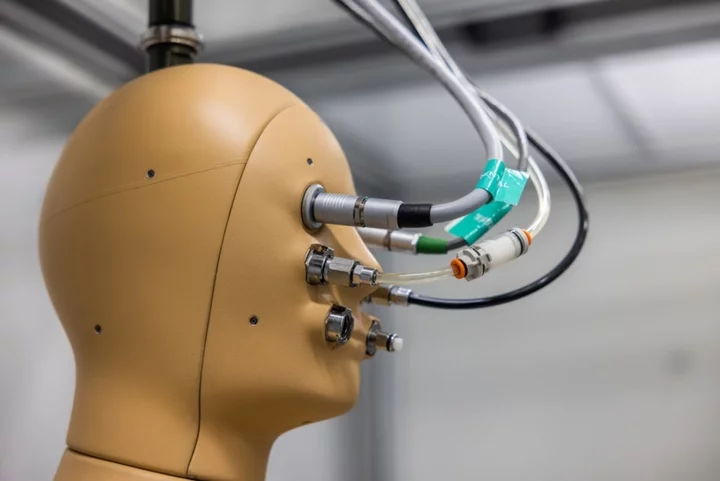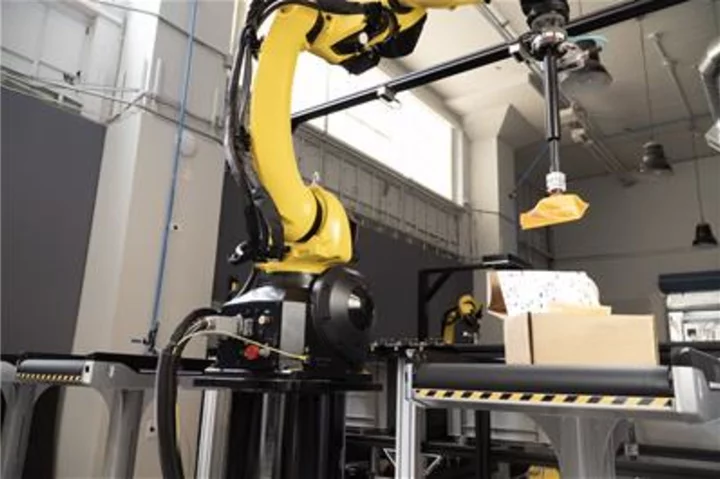
‘Stoner Cats’ NFTs Creator Settles With SEC Over Unregistered Securities Sales
The creator of animated series Stoner Cats, which featured actors Mila Kunis and Ashton Kutcher, agreed to pay
2023-09-14 05:19

Overwatch 2 no longer getting co-op PvE hero mode
Blizzard has detailed in depth why it is no longer bringing the anticipated mode to the title.
2023-05-17 20:27

Microsoft to offer OpenAI's GPT models to government cloud customers
(Reuters) -Microsoft Corp is bringing the powerful language-producing models from OpenAI to U.S. federal agencies using its Azure cloud service,
2023-06-08 03:15

WhatsApp update stops hackers being able to find your phone by calling it
A new WhatsApp feature could stop people from being found through phone calls, the company has said. The tool, named “Protect IP Address in Calls”, is aimed at letting people ensure that they do not give away unwanted information to the people who call them up. At the moment, WhatsApp calls are made in one of two ways: peer-to-peer or through WhatsApp’s servers. The new setting allows users to choose between them to ensure that they are able to keep information private. Peer-to-peer calling works as it sounds: the two phones are directly in contact. That usually allows for better call quality, but means that the two phones need to know each other’s IP address. If calls are instead relayed through WhatsApp’s servers, it means that the IP address can be kept secret. That address could potentially be useful to hackers or other malicious cyber criminals, since it can be used to work out a person’s general location or their internet provider. Now users can choose to use the new feature and always have their calls sent through WhatsApp’s servers and protect their IP address. WhatsApp cannot intercept those calls even when they go through its servers since they are end-to-end encrypted. WhatsApp stressed that the new feature is aimed at their “most privacy-conscious users”. It may lead to less fast connections and lower quality calls, for instance. The new update follows another, released over summer, which WhatsApp refers to as “Silence Unknown Calls”. That stops phone calls from unknown numbers from even getting through to your phone – which means that it will not only limit spam and other annoying calls, but will also keep people cyber attacks, WhatsApp said. Read More Apple just released an iPhone update you should download right now Nasa gets ‘puzzling’ data back from spacecraft exploring distant object Scientists invent mind-reading device
2023-11-09 03:22

South Africa Weighs Extending Lives of Larger Coal Power Plants
South Africa is considering extending the lives of some of its biggest coal-fired power plants as the government
2023-05-24 17:17

Apple event - live: iPhone 15 to bring new charging port and high price as Watch and AirPods update expected
Apple is about to launch four new iPhones, two new Watches and maybe more besides. The launch of the iPhone 15 is the biggest event in Apple’s year, and could bring extra controversy this year, given a widely rumoured higher price and new charging port at the bottom of the phone. Alongside those updates, Apple is rumoured to be planning new charging technology, faster chips, better battery life and design tweaks for the higher-end, Pro versions of the phone. In all, there is expected to be four versions of the iPhone 15: the base model, the iPhone 15 Plus, the Pro and Pro Max. In addition to those new products, Apple is widely expected to update both the normal and Ultra version of the Apple Watch. They are expected to receive small updates, with the possible introduction of new chip technology. The AirPods may also feature in the event. They are also expected to receive an update to swap the Lightning charging port in the bottom for USB-C – beginning the process of getting rid of a charging technology that has been used for more than a decade in Apple’s most popular products. The event will be live streamed from Apple’s California headquarters, beginning at 10am local pacific time, 1pm eastern, or 6pm in the UK. You can follow all the latest news here.
2023-09-12 17:54

Vanishing Ice on Highest Mountains Threatens Quarter of Humanity
Rapidly melting glaciers in Asia’s Hindu Kush Himalayan region — home to the world’s highest mountains — are
2023-06-20 09:58

US Navy Chooses Pitney Bowes to Assist in Package Distribution Worldwide
STAMFORD, Conn.--(BUSINESS WIRE)--May 31, 2023--
2023-05-31 21:26

SpaceX Starship: Elon Musk’s company launches most powerful rocket in the world for first ever time
SpaceX has successfully launched Starship, the world’s most powerful rocket, for the first ever time. The spacecraft took off from Texas early on Saturday local time. It marked SpaceX’s second attempt to launch the spacecraft, after a previous test in April saw the rocket exploded soon after launch. The booster that carried the spacecraft up towards orbit exploded after it detached from the main spacecraft. SpaceX said that it had known there was a chance that the booster would be destroyed in the launch. But the main part of the ship successfully carried on towards the edge of space. Eventually, SpaceX hopes that Starship will fly to the Moon and help with missions to Mars. But first it must undergo a series of uncrewed tests to ensure it is safe. Elon Musk - SpaceX‘s founder, chief executive and chief engineer - also sees Starship as eventually replacing the company’s workhorse Falcon 9 rocket as the centerpiece of its launch business that already lofts most of the world’s satellites and other commercial payloads into space. NASA, SpaceX‘s primary customer, has a considerable stake in the success of Starship, which the US space agency is counting on to play a central role in its human spaceflight program, Artemis, successor to the Apollo missions of more than a half century ago that put astronauts on the moon for the first time. Starship’s towering first-stage booster, propelled by 33 Raptor engines, puts the rocket system’s full height at some 400 feet (122 meters) and produces thrust twice as powerful as the Saturn V rocket that sent the Apollo astronauts to the moon. SpaceX is aiming to at least exceed Starship-Super Heavy’s performance during its April 20 test flight, when the two-stage spacecraft blew itself to bits less than four minutes into a planned 90-minute flight. That flight went awry from the start. SpaceX has acknowledged that some of the Super Heavy’s 33 Raptor engines malfunctioned on ascent, and that the lower-stage booster rocket failed to separate as designed from the upper-stage Starship before the flight was terminated. The company’s engineering culture, considered more risk-tolerant than many of the aerospace industry’s more established players, is built on a flight-testing strategy that pushes spacecraft to the point of failure, then fine-tunes improvements through frequent repetition. A failure at any point in the test flight would be a major concern for NASA, which is counting on SpaceX‘s rapid rocket development ethos to swiftly get humans to the moon in the U.S. competition with China’s lunar ambitions. Judging the success or failure of the outcome may be less than clear-cut, depending on how far the spacecraft gets this time. NASA Administrator Bill Nelson, who has made the China rivalry a key need for speed, compared Starship’s test campaign with the success of SpaceX‘s past rocket development efforts. “How did they develop the Falcon 9? They went through many tests, sometimes it blew up,” Nelson told Reuters on Tuesday. “They’d find out what went wrong, they’d correct it then go back.” The combined spacecraft in April reached a peak altitude of roughly 25 miles (40 km), only about halfway to space at its target altitude of 90 miles (150 km), before bursting into flames. Musk has said that an internal fire during Starship’s ascent damaged its engines and computers, causing it to stray off course, and that an automatic-destruct command was activated some 40 seconds later than it should have to blow up the rocket. The launch pad itself was shattered by the force of the blastoff, which also sparked a 3.5-acre (1.4-hectare) brush fire. No one was injured. SpaceX has since reinforced the launch pad with a massive water-cooled steel plate, one of dozens of corrective actions that the U.S. Federal Aviation Administration required before granting a launch license on Wednesday for the second test flight. Additional reporting by agencies Read More SpaceX launches ‘zero fuel’ engine into space SpaceX is launching the world’s biggest rocket – follow live SpaceX to launch world’s biggest rocket again after first attempt ended in explosion The world’s most powerful rocket should launch imminently, Elon Musk says Why Apple is working hard to break into its own iPhones OpenAI co-founder Sam Altman ousted as CEO
2023-11-18 21:17

CardFree Launches ‘Checkout,’ The Most Comprehensive Wallet Offering for Merchants
SAN FRANCISCO--(BUSINESS WIRE)--May 10, 2023--
2023-05-10 22:24

Tax Strategists are Positioned to Influence Critical Business Matters
CHICAGO--(BUSINESS WIRE)--Jun 14, 2023--
2023-06-14 21:28

Diablo® IV Crosses $666 Million Sell-Through within Five Days of Launch, Setting New Blizzard All-Time Record
IRVINE, Calif.--(BUSINESS WIRE)--Jun 12, 2023--
2023-06-13 04:21
You Might Like...

Can AI Replace Your Fund Manager? In Time, Yes.

Scientists invent first ever ‘breathing, sweating, shivering’ robot

Pennsylvania Convention Center Authority Connects Approximately 1 Million Annual Guests Across More Than 2 Million Sq. Ft. With HPE Aruba Networking Wi-Fi 6E Infrastructure

Eyas™ Medical Imaging Brings State-of-the-Art MRI to NICUs, Revolutionizing Access for Fragile Newborns

The best sex and dating apps for finding a hookup

OSARO Targets Fast-Growing Subscription Market with AI-Powered Kitting Robots

Ubitransport becomes Matawan and sets out to conquer Europe

Integer Technologies Completes At-Sea Testing on UUV Digital Twin Architecture Prototype as Part of a DARPA SBIR Phase 2 Award
